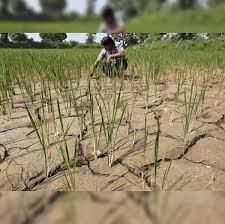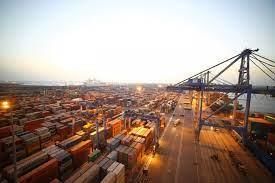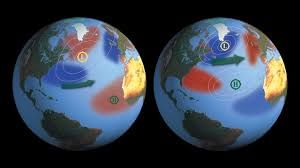Geography - 2 | Current Affairs & Hindu Analysis: Daily, Weekly & Monthly - UPSC PDF Download
Monsoon, El Nino, and Their Impact on Agriculture
The onset of the 2023 southwest monsoon season in India faced a delayed start, with the initial two weeks marked by a substantial rainfall deficit, registering 52.6% below the normal long-period average (LPA).
- However, as of July 30, 2023, there has been an overall reversal, showcasing a 6% surplus in rainfall. This turnaround has had a positive impact on kharif crop plantings. Nevertheless, concerns linger about the potential repercussions of the impending El Niño phenomenon on rabi crops.
Understanding Long-Period Average (LPA) of Rainfall
The Indian Meteorological Department (IMD) defines "LPA of rainfall" as the average rainfall recorded over a specific region for an extended period, typically 30 or 50 years. The IMD categorizes rainfall into five groups on an all-India scale:
- Normal or near normal: Rainfall ranging between 96-104% of LPA.
- Below normal: Rainfall between 90-96% of LPA.
- Above normal: Rainfall between 104-110% of LPA.
- Deficient: Rainfall falling below 90% of LPA.
- Excess: Rainfall exceeding 110% of LPA.
What are Kharif and Rabi Crops?
Kharif Crops:
- Kharif crops are planted during the monsoon season, typically from June to October, and are harvested in late summer or early autumn.
- These crops rely on the southwest monsoon for irrigation and growth.
- Major Kharif crops include rice, maize, sorghum, pearl millet (bajra), finger millet (ragi), groundnut, and pulses such as pigeon pea (arhar) and green gram (moong).
- They contribute to about 55% of India's total foodgrain production.
Rabi Crops:
- Rabi crops are sown around the time of the Retreating Monsoon and Northeast monsoon, beginning in October, and are termed winter crops.
- Harvesting for these crops typically occurs during April and May, in the summer season.
- Major Rabi crops include wheat, gram, peas, barley, etc.
- These crops require warm temperatures for seed germination and cold weather for growth.
Impact of Monsoon on Indian Agriculture:
Positive Impacts:
- Increased Crop Production: A significant portion of the country's crop area heavily relies on Monsoon rains, lacking manual irrigation methods.
- Adequate monsoon rainfall enhances soil moisture, fostering crop growth and resulting in higher agricultural yields.
- The availability of water supports the cultivation of diverse crops, including rice, wheat, millets, and pulses.
- Economic Boost: Successful monsoon seasons contribute to rural prosperity by generating income for farmers and laborers, stimulating demand for goods and services in the rural economy.
- This increased economic activity positively influences overall national growth.
- Groundwater Recharge: The monsoon aids in recharging groundwater resources, crucial for sustainable agricultural practices in regions facing water scarcity.
Negative Impacts:
- Erratic Monsoon Patterns: The unpredictable timing, intensity, and distribution of the monsoon lead to uncertainties in agricultural planning and crop management.
- Delayed or early monsoons can disrupt planting schedules, impacting crop yields.
- Droughts and Floods: Monsoon failure or excessive rainfall can result in droughts or floods, respectively, both posing significant threats to agriculture. Droughts lead to water shortages, crop failures, and reduced yields, while floods damage crops, erode topsoil, and cause livestock losses.
- Crop Losses: Prolonged and excessive monsoon rains can cause crop diseases, reducing both crop quality and yield. These conditions also impede farmers' ability to carry out effective agricultural operations.
- Soil Erosion: Heavy rainfall can lead to soil erosion, depleting soil fertility and affecting agricultural productivity in the long term. Soil erosion also impacts water bodies, leading to siltation in reservoirs and reducing their storage capacity.
- Food Price Inflation: Inconsistent monsoon patterns can affect crop production, resulting in shortages and food price inflation. This can adversely impact the economy, particularly for low-income households spending a significant portion of their income on food.
What is El Nino and Its Impact on Agriculture?
Overview:
- El Nino is an irregular climate phenomenon occurring in the tropical Pacific Ocean, marked by the warming of sea surface temperatures. It can exert significant influences on global weather patterns, including those in India.
- In June 2023, the Oceanic Nino Index (ONI) exceeded the El Nino threshold of 0.5 degrees, reaching 0.8 degrees Celsius. Global weather agencies predict the persistence and strengthening of El Nino throughout the 2023-24 winter.
Implications:
- Temperature Extremes: El Nino is frequently linked to heightened temperatures in certain regions of India. Elevated temperatures can adversely affect crops, causing heat stress and diminishing yields, particularly for sensitive crops such as fruits and vegetables.
- Pest and Disease Outbreaks: El Nino conditions create favorable conditions for certain pests and diseases that impact crops. Warmer temperatures and altered precipitation patterns can lead to an upsurge in pest populations, presenting additional challenges for farmers.
- Impact on Livestock: Reduced fodder availability and water scarcity during El Nino can impact livestock and animal husbandry, resulting in lower production of milk and meat.
Equatorial Origin Cyclones and Pacific Decadal Oscillation
Equatorial-origin cyclones have displayed an unusual quiescence in recent decades.
- However, a study featured in the journal Nature Communications suggests that the combination of global warming and the Pacific Decadal Oscillation (PDO) may lead to an increased frequency of such cyclones in the coming years.
Understanding Equatorial-Origin or Low Latitude Cyclones
- Equatorial-origin or Low Latitude Cyclones (LLCs) originate between 5°N and 11°N. While smaller in size compared to their higher-latitude counterparts, these cyclones intensify more rapidly.
- The occurrence of cyclones near the equator (low-latitude) is typically uncommon. However, when the waters are warm, these cyclones can absorb more moisture and escalate in intensity.
- The majority of these cyclones originate in the Western Pacific Ocean. The last significant cyclone of this nature in the Indian vicinity was the 2017 Cyclone Ockhi, which traversed over 2000 km and wrought havoc in Kerala, Tamil Nadu, and Sri Lanka.
- The north Indian Ocean (NIO) in the post-monsoon season (Oct-Nov-Dec) is a hotspot for LLCs, constituting approximately 60% of all Tropical Cyclones formed in the NIO since 1951. Despite this prevalence, it has received relatively less attention.
What is the Pacific Decadal Oscillation (PDO)?
Overview:
- The Pacific Decadal Oscillation (PDO) is a prolonged oceanic fluctuation in the Pacific Ocean. This cyclical event occurs approximately every 20-30 years and, akin to ENSO, undergoes 'cool' and 'warm' phases. The term PDO was coined by Steven Hare around 1996.
Impact of PDO:
- On Global Climate: The PDO phase carries substantial implications for the global climate, influencing Pacific and Atlantic hurricane activity, droughts, and flooding across the Pacific basin, the productivity of marine ecosystems, and patterns of global land temperatures.
- On Cyclones: A warmer (positive-phased) PDO correlates with fewer equatorial-origin cyclones. In 2019, the PDO entered a cooler, negative phase, potentially indicating an increase in such cyclones during post-monsoon months.
ENSO and PDO:
- ENSO paired with a positive PDO is generally unfavorable. Conversely, ENSO coupled with a negative PDO brings increased rainfall to India. When both ENSO and PDO are in the same phase, the impacts of El Niño/La Niña may be intensified.
PDO vs. ENSO:
- El Niño or La Niña events occur in the Pacific every 2-7 years, while the PDO exhibits a longer-term signature (on a decadal scale).
- Determining whether the PDO is in a 'positive' or 'warmer phase' requires several years of measuring ocean temperatures and their interaction with the atmosphere, contrasting with the annual determination of an ENSO stage.
Container Terminal Project at Deendayal Port
The recent collaboration between the Deendayal Port Authority and the Dubai-based DP World for the Mega Container Terminal Project at Tuna Tekra, Gujarat, has garnered attention. This initiative, spearheaded by India's Ministry of Ports, Shipping & Waterways (MoPSW), marks a significant stride in public-private partnership, aiming to augment port capacity, bolster multimodal logistics, and enhance global connectivity.
Key Highlights of the Container Terminal
- Annual Capacity: The terminal is poised to handle an annual capacity of 2.19 million twenty-foot equivalent units (TEUs), equipped to accommodate next-generation vessels carrying over 18,000 TEUs.
- Green Port Compliance: The Mega Container Terminal Project adheres fully to green port guidelines, emphasizing environmental sustainability.
- Regional Connectivity: The terminal will establish crucial connections between Northern, Western, and Central India with the global market.
- Vision 2047 Alignment: This project aligns seamlessly with India's Vision 2047, aimed at quadrupling port handling capacity.
- National Infrastructure Pipeline: The terminal integrates into the National Infrastructure Pipeline, complementing the PM Gati Shakti initiative.
- Economic Transformation: Anticipated to reshape the economic landscape of Kutch, the Container Terminal is expected to generate ancillary services like warehousing and create both direct and indirect employment opportunities.
What are the Key Points About Deendayal Port?
- Deendayal Port, also known as Kandla port, is one of the twelve Major Ports in India and is located on the West Coast of India, in the Gulf of Kutch in the State of Gujarat.
- Deendayal Port primarily services northern India, including the landlocked Jammu and Kashmir, Uttar Pradesh, Madhya Pradesh and Rajasthan.
- Deendayal Port’s journey began in 1931 with the construction of RCC Jetty by Maharao Khengarji. After the independence of India in 1947, Deendayal Port emerged to be India’s No. 1 Port in the year 2007-08 and has retained the top position for the 14th consecutive year since then.
- In 2016, Deendayal Port created history by handling 100 MMT cargo in a year – the first Major Port to achieve this milestone.
- It is the largest port in India by volume of cargo handled.
El Nino Southern Oscillation
As the El Nino phenomenon is highly likely to impact the Indian monsoon this year, there is considerable optimism surrounding the potential development of a positive Indian Ocean Dipole (IOD) to offset the effects of El Nino.
What is ENSO (El Nino and Southern Oscillation)?
- ENSO stands out as one of the most significant climate phenomena globally, given its capacity to alter the overarching atmospheric circulation on Earth, subsequently impacting temperature and precipitation patterns across the planet.
- Despite being a singular climate phenomenon, ENSO manifests in three distinct states or phases:
El Nino:
- Characterized by a warming of the ocean surface, leading to above-average sea surface temperatures (SST) in the central and eastern tropical Pacific Ocean.
- Associated with reduced monsoon rainfall in India.
La Nina:
- Marked by a cooling of the ocean surface, resulting in below-average SSTs in the central and eastern tropical Pacific Ocean.
- Associated with relatively improved monsoon rainfall in India.
Neutral:
- Neither El Nino nor La Nina.
- Often observed when tropical Pacific SSTs are generally close to average.
What is Indian Ocean Dipole (IOD)?
- The Indian Ocean Dipole (IOD) is defined by the difference in sea surface temperature between two areas (or poles, hence a dipole) – a western pole in the Arabian Sea (western Indian Ocean) and an eastern pole in the eastern Indian Ocean south of Indonesia.
- In scientific terms, the IOD is a coupled ocean and atmosphere phenomenon, similar to ENSO but in the equatorial Indian Ocean.
- A ‘positive IOD’ — or simply ‘IOD’ — is associated with cooler than normal sea-surface temperatures in the eastern equatorial Indian Ocean and warmer than normal sea-surface temperatures in the western tropical Indian Ocean.
- The opposite phenomenon is called a ‘negative IOD’, and is characterised by warmer than normal SSTs in the eastern equatorial Indian Ocean and cooler than normal SSTs in the western tropical Indian Ocean.
- The IOD was identified as an independent system only in 1999.
Impact of IOD on Southwest Monsoon:
- There is currently no established correlation between Indian summer monsoon rainfall and the Indian Ocean Dipole (IOD). However, research indicates that during a positive IOD year, there tends to be above-average rainfall over central India.
Summary of the News:
- As the El Nino phenomenon is highly likely to impact the Indian monsoon this year, there is substantial optimism regarding the potential emergence of a positive Indian Ocean Dipole (IOD) and its ability to counteract the effects of El Nino. A positive IOD holds the promise of mitigating the impacts of El Nino to a certain extent in neighboring regions, as it has demonstrated in the past, notably in 1997.
- While El Nino is already well-established in the Pacific Ocean this year, the IOD currently remains in the neutral phase. All global climate models suggest the possibility of a positive IOD event developing in the upcoming months. According to the India Meteorological Department (IMD), there is an 80% likelihood of a positive IOD occurrence in the coming months, as stated in its recent bulletin.
Earthquake in Morocco
On the 8th of September 2023, Morocco experienced its most potent earthquake to date, registering a magnitude of 6.8. The epicenter was situated in the Al-Haouz province, within the Atlas Mountains, in close proximity to the historic city of Marrakech.
- The aftermath of the earthquake saw a sequence of aftershocks, including a 4.9 magnitude tremor, further exacerbating the distress in the region.
Causes of the Morocco Earthquake:
- The seismic event was a consequence of the convergence between the African plate and the Eurasian plate along a complex plate boundary.
- The faulting mechanism of the earthquake was classified as "oblique-reverse," denoting movement along the fault plane where the upper block moves upward and over the lower block within the Moroccan High Atlas Mountain range.
- Faults, defined as fractures in rock formations facilitating relative movement of rock blocks, can induce earthquakes with rapid movement.
- Faults are differentiated by their dip (angle concerning the surface) and slip direction.
- Dip-slip faults encompass normal faults (upper block descends below the lower block) and reverse faults (upper block ascends and traverses over the lower block), with reverse faults prevalent in regions experiencing tectonic compression.
- Strike-slip faults involve lateral movement along the fault plane.
- Oblique-slip faults exhibit characteristics of both dip-slip and strike-slip faults.
- The earthquake took place at a relatively shallow depth beneath the Earth's surface, amplifying its potential for destruction.
- Shallow earthquakes pose greater danger because of their close proximity to the Earth's surface.
- Compared to deeper quakes, they unleash more energy, enhancing their potential for devastation.
- Deeper earthquakes dissipate energy as seismic waves traverse longer distances.
|
44 videos|5271 docs|1113 tests
|
FAQs on Geography - 2 - Current Affairs & Hindu Analysis: Daily, Weekly & Monthly - UPSC
| 1. What is the impact of El Nino on agriculture? |  |
| 2. How does the Pacific Decadal Oscillation affect agriculture? |  |
| 3. What are Equatorial Origin Cyclones and how do they impact agriculture? |  |
| 4. How does Monsoon affect agriculture? |  |
| 5. What was the impact of the earthquake in Morocco on agriculture? |  |


























